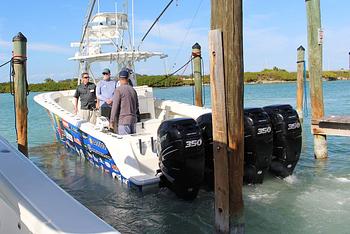Sailing around the world. It’s a dream so many of us ocean lovers hold. We fantasize about the idea of casting off and cruising to all the corners of our blue planet, exploring far off lands and being beholden to no-one but Mother Nature (and a bit of red tape). While it’s not by any means an easy feat, sailing around the world is indeed more doable than many believe. With the right preparation, the right mindset, the right yacht and equipment, and a huge sense of adventure, you can turn that dream into a reality. Here we take a look at the first things you need to consider.
Planning
It can’t be reiterated enough, don’t rush the planning stages of your trip. Take at least a year to plough through a long to do list, and get you and your yacht prepared for this epic journey. There is much to consider, from buying the right yacht, to equipment, provisions, route, red tape and even home-schooling the kids while you’re underway. Spend as much time as you can on the water, and if possible embark on smaller trips to iron out any unforeseen issues that might arise, while getting a feel for life on the seas as a family.
For inspiration and a sense of real life sailing the world, read first-hand stories from those who have done it. There are many heart-warming and fascinating blogs out there from people who have cast off from the rat race and sailed the seas, whether it’s as a family like Family Sailing (https://www.familsailing.co.uk/) or Sailing Totem, or even with their pets like Bailey Boat Cat.
The Yacht
The most important decision you’ll make when preparing to sail around the world, and the one that will have the biggest impact on your budget – both when you’re in the planning phase and later whilst cruising – is which type of yacht to buy. Do you opt for one or two hulls? Trends over the last five years in the multihull sector offering charter style family cruisers with maximum space, improvement in the speed, styling and handling ability of catamarans built in series production. This is arguably the only market in yachting that has continued to grow throughout the recession. Why To Buy A Sailing Catamaran.
You will be blue water cruising over long periods of time so needless to say you want a yacht that is up to the task in terms of safety, comfort, performance and functionality.
Everyone you ask will have a different opinion, and ultimately it’s a very personal decision. But getting it right will drastically impact everything from your enjoyment of the trip, to personal relations on board, as well as your sense of security. One of the key points to take into consideration is the size. You need to find the right size yacht to fit your budget, number of people on board and cruising grounds. Go too big, and it’s not just the initial outlay which goes up. Insurance, repairs, mooring and a whole host of factors suddenly go up too, meaning your monthly budget needs to be increased. Go too small and you’ll find personal space an issue, and storage even more so. The 36 – 48 feet (12 - 15 metres) yachts tend to be favoured for their good sea-keeping ability, good steering ability, self-steering arrangements, good storage capabilities and a decent sailing speed.
Compare Rightboat’s selection of Blue Water Cruising Yachts with the Multihull Boats for Sale.
The Equipment
Your round the world equipment list is going to be about as long as your voyage, so get organized, do your research and know what you need. Keep in mind that the I-hope-we-don’t-need-those items are as important as the everyday essentials and that everything will need to find a storage place.
Keeping your family safe onboard will your biggest consideration, so allocate sufficient budget for safety and communication equipment. You’ll also need a dinghy, oars, outboard plus fuel storage cans, anchors, anchor plus plenty of spare chain and spare rode, sails, warps, spare sheets, sails, spare fuel in tanks, additional batteries, storm anchor, trysail, engine spares, storm equipment, tools, pilots, and charts, fishing gear, BBQ. Some of the more expensive items of equipment include SSB radio, comprehensive first aid kit, satellite phone and air time, and trackers and routers. The list is endless and doesn’t even touch on personal items.
The Red Tape
Cruising into a country’s territorial waters has a very different set of rules and regulations that if you crossed a land border or arrived through an international airport. Not knowing in advance what paperwork, permits or visas you might need could land you in hot water – and not the clear, tropical kind. In fact, some of these regulations might include making contact before you even enter territorial waters, so once you’ve planned your route start the arduous but critical task of knowing what you need before you set sail.
You may need to have arranged a visa beforehand or bought a permit for the boat. Officials may require an inventory of everything on board, as well as a crew list, or you might be asked to present original documents at very regular intervals whilst in some countries. Documents you might need include your boat license, insurance certificate, radio license, VAT Paid certificate and exit documents While it may be wise to hire an agent in countries where the bureaucracy and language may be hindrances – usually in off the beaten track destinations - in others a costly agent might be mandatory, so be aware of additional costs and add them to your budget.
Worth reading our boat licencing articles for Europe, UK and the USA for more information too.
The Route
You’ll no doubt have dreams of places you want to visit, so let those be your guide in creating your route. Where you’re starting out from will dictate when you can start your journey and the most favourable weather conditions. You want to avoid hurricane seasons in the Pacific, Atlantic and Indian oceans, so you're leaving date will be dictated by those.
The world is a big place, filled with wonder and adventure. From the far-flung tropical idylls of the Pacific islands to the picturesque Mediterranean bursting with culture, this is ultimately what your trip is all about. Relish in the wanderlust of sitting with a map spread in front you of, of dreaming about snorkeling in the Indian Ocean’s coral reefs, of coming face to face with seals and sharks in the Galapagos Islands. Considered by many to be somewhat of a Bible for round-the-world, World Cruising Routes by Jim Cornell is an excellent resource.
You’ll want to consider how long you want your trip to last. Are you setting off to do it as quickly as possible, or take your time over several years and take it all in? One option to consider if time and budget allow is cruising for half the year and avoiding the off-season weather. It gives all on a board a chance to refresh, get maintenance work done on the boat, top up provisions, visit family and friends back home, and be ready to set off again once the trade winds are more favourable. For those who would rather have the security and peace of mind of having other yachts nearby, the World ARC is a flotilla which begins in Saint Lucia or Australia and covers a 26000NM trade wind circumnavigation with assistance in each port to help with red tape and logistics.
The Budget
With dreams comes a reality, and that reality usually boils down to money. You need to create a realistic, carefully thought out and well-researched budget before as your very first step on the road to sailing around the world.
You’ll need to consider the cost of the yacht, the equipment, boat insurance, and health insurance, in other words, set up and annual fixed costs. While these are easy to estimate, your on-going monthly costs are harder to gauge. You’ll have to consider fuel, food provisions, repairs, maintenance, marina/mooring fees, cruising permits, visas and red tape, tours, and trips, eating out, and perhaps flights back periodically to visit friends and family.
We’ve already looked at how the size of the boat you buy will affect your monthly budget, so it’s important to keep that in mind and buy a boat that you can afford to run. But when you’re out on the high seas, a lot of your budget will depend upon the lifestyle you wish to live. A barebones budget won’t allow for luxuries like eating out or excursions, and maintenance can be scheduled for cheaper countries. Anchoring rather than marina moorings will save a hefty amount, as will only sailing rather than motoring. Indeed, putting more equipment on board to begin with to make you more self-sufficient might seem like an extra cost but will save you money in the long-run. Equipment such as watermakers, large fuel tanks and extra provisioning storage means you’re not dependent on marinas.
We really hope this gives a good insight into the preparation required to set off on your dream trip, the next step is to find the right boat. Start your boat search today!




